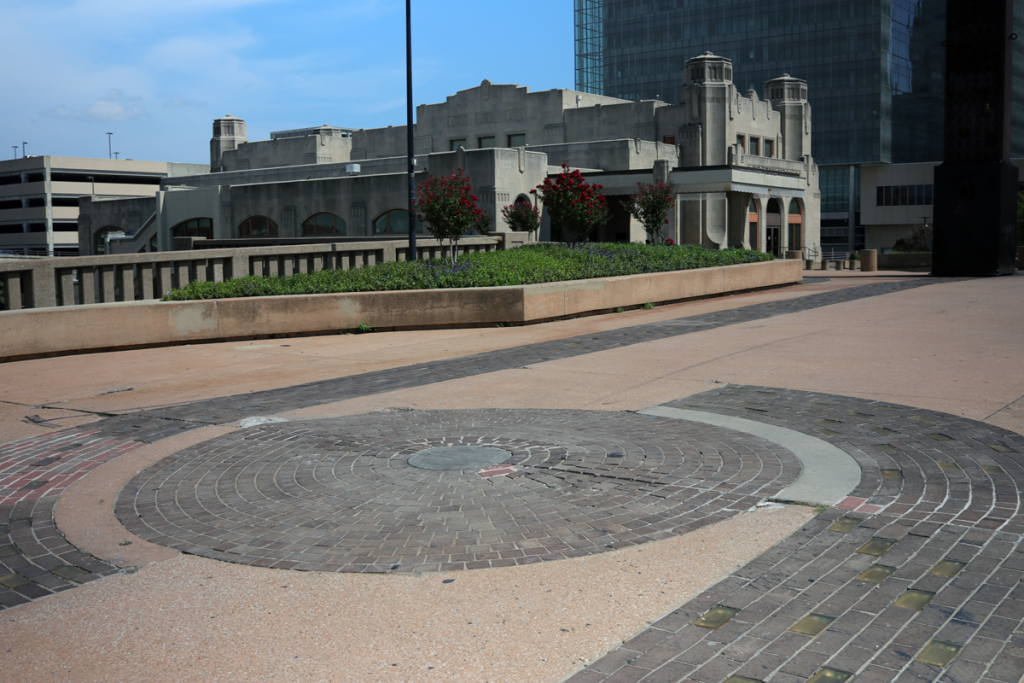The Center of the Universe, Oklahoma Edition
As far as we know, no human has ever been to the actual center of the Universe. But depending on how you imagine it, it could be a place where you’re all alone and everything seems to orbit around you as if nothing else matters. And if you speak, perhaps, you’ll hear nothing but your voice echoing back at you, a reminder of both your perceived omnipotence and actual solitude.
Few, if any of us, will ever experience that, though. The center of the Universe, wherever it is, is not somewhere on Earth.
But maybe a weird spot on a pedestrian bridge in Tulsa, Oklahoma, is close enough.

Tulsa is split, north-south, by a railway line, but most of the avenues in the area cross the tracks regardless, typically as bridges. The most notable exception is Boston Avenue; South Boston Avenue and North Boston Avenue no longer connect, as seen in this Google Maps satellite view. That’s a relatively new aberration, though. In the 1980s, the Boston Avenue Bridge burned down, and when the city went to rebuild it, they decided a pedestrian crossing was more important than yet another car path. The resulting thoroughfare can be seen above; and it doesn’t look like much, it’s just a circle in the middle of a bridge, surrounded by a larger circle, which itself is framed by a swirl-like design extending toward either end of the bridge. On the sides of the bridge are short concrete walls, designed to keep people away from the edge. Except for in the center of the bridge, those short walls are separated from the edges by some shrubberies, but in the center of the bridge, the walls mirror the circular design, leaving no room for the bushes.
It’s a nice aesthetic, but nothing special if you’re a sightseer. But if you’re a soundhearer (to coin a term), it’s magic. If you stand in the smaller circle in the middle of the larger circle, you’ll notice something pretty neat: despite the fact that the bridge is in an open space with neither walls around it nor a ceiling above, if you speak at a normal volume, your voice will echo back at you. In 2016, a news crew from KJRH Tulsa captured the effect on video; you can experience it here. And, as KJRH notes, “anyone standing outside the circle won’t hear what you hear” — the reverberation effect is localized to people in that larger circle.
The effect is a “focusing anomaly” according to Shane Wood, director of the Tulsa Foundation of Architecture, per KJRH. As Roadside America notes, “the small, well-worn disc of cement at the center of the swirl (sometimes mistaken for a manhole cover) naturally attracts walkers as a kind of bulls-eye,” and when they stop there and talk, the soundwave from their voices bounce around those short concrete walls, ultimately coming back to the speaker’s ears. If you’re standing too far from that “bulls-eye,” you’re no longer at the focal point of the circle, and therefore, you’ll not hear the echo. It’s a cool enough effect that an estimated 10,000 tourists visit the spot each year.
And amazingly, when the city planners created the pedestrian bridge, they didn’t intentionally create this experience. Per Roadside America, “whoever was responsible for the design did not realize that if someone stands on the disc and speaks, their voice becomes mysteriously amplified and distorted” — the designers were just trying to make an aesthetically-pleasing pedestrian pathway. As a result, the explanation for why the effect happens post-dates the discovery of the effect by a good amount, and plenty of folk theories have emerged and persevered. Locally, the spot is called the “Tulsa Center of the Universe,” further giving a mythic halo to the accidental tourist attraction and science experiment.
Bonus fact: Oklahoma is the only U.S. state with an official state meal — and it’s probably not something you should be eating regularly. The meal consists of a bunch of dishes: “fried okra, squash, cornbread, barbecue pork, biscuits, sausage and gravy, grits, corn, black-eyed peas, chicken-fried steak, strawberries and pecan pie,” according to the Oklahoma Gazette. And nutritionally, it’s a lot for one or even multiple sittings. As Wikipedia’s editors summarize, “depending on portion sizes, the entire meal might contain 2,700 calories, 125 g fat, and 5,250 mg sodium, all in excess of a day’s recommended intake.”
From the Archives: The Space Capsule That Crashed in Oklahoma: 45 minutes from Tulsa is another odd tourist attraction.
